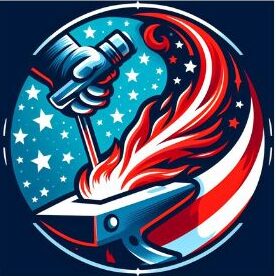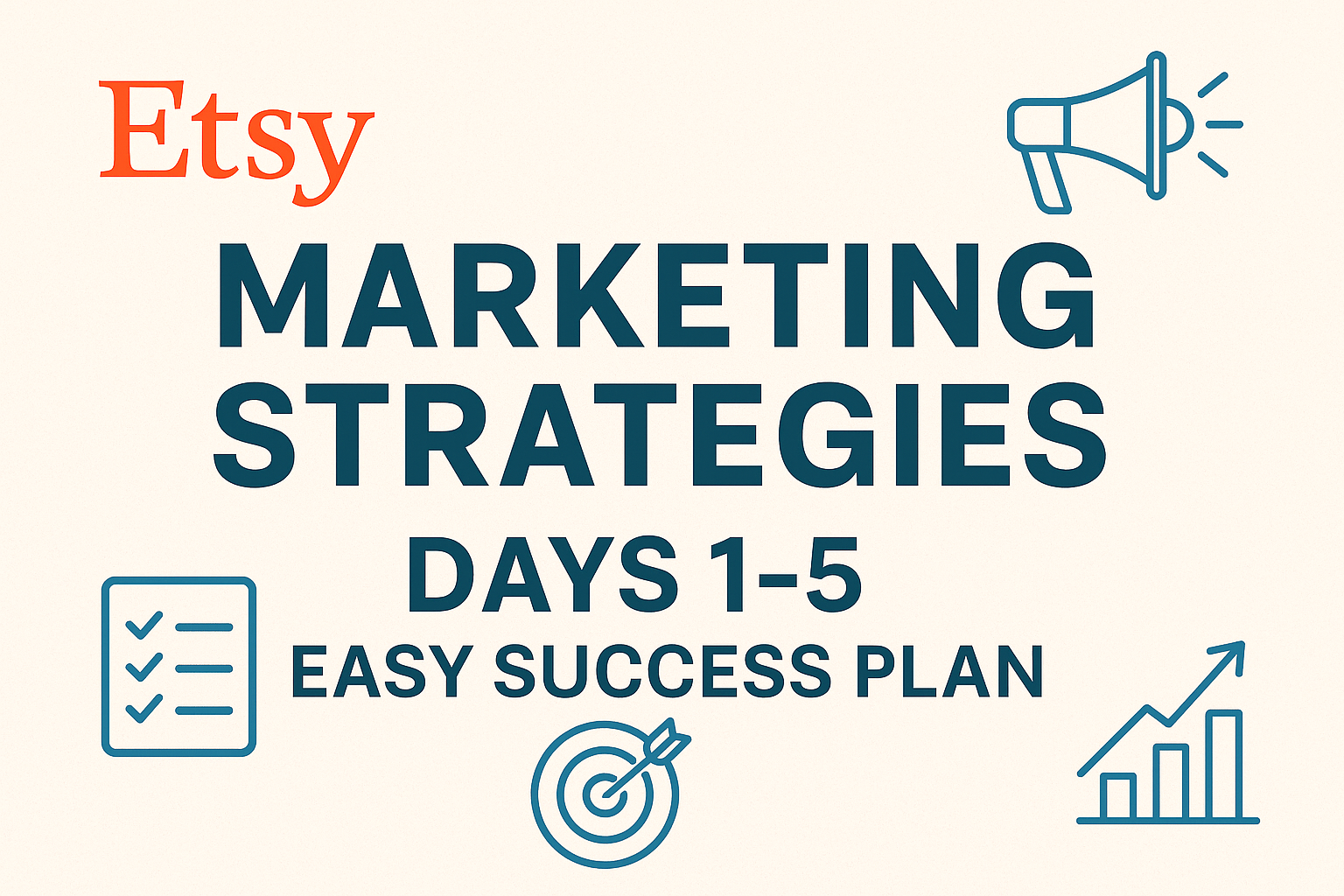This post expands the first five days of our 30-Day Etsy Bootcamp so you can lay a rock-solid foundation fast. If you haven’t read the master guide yet, start here: Etsy Marketing Strategies (Pillar).
Etsy Marketing Strategies: Days 1–5 Easy Success Plan
These first five days determine how easy (or hard) your next 30 will be. Most sellers rush into listings and ads; the better approach is to clarify your buyer, validate demand, choose a product path, lock your brand style, and set up your shop like a high-converting landing page. Follow the steps below and you’ll avoid 80% of beginner mistakes with your etsy marketing strategies.
Day 1: Persona, Promise, and Brand Story
Every effective set of etsy marketing strategies begins with a single, specific buyer. You’re not selling “to everyone on Etsy.” You’re serving one person with one persistent problem or desire. Clarify that person and everything else—keywords, photos, pricing—gets easier.
Define One Buyer Persona
- Who they are: e.g., “Teachers who love organization and cute classroom décor.”
- What they want: “Printables that save prep time and make the room feel joyful.”
- Constraints: “Busy, low budget, prefers instant downloads.”
Write a Simple Value Promise
“I help [persona] get [outcome] with [product] so they can [benefit].” Example: “I help busy teachers save planning hours with done-for-you classroom printables so they can focus on students.” Use this promise as your north star for titles, descriptions, and photos in your etsy marketing strategies.
Tell a Short, Credible Brand Story
People buy from people. Share a 3–5 sentence origin: the moment you realized the problem, the solution you crafted, and the standards you hold. Keep it buyer-centric and avoid filler. You’ll reuse this story in your About section and product descriptions.
Deliverable (15 minutes)
- 1-page “Brand Brief” with persona, promise, and story.
- 5 adjectives for tone/visuals (e.g., calm, bright, minimalist, cozy, playful).
Day 2: Keyword & Competitor Research (Proof of Demand)
Great etsy marketing strategies validate demand before building a catalog. You’re looking for keywords with buyer intent and listings that prove people pay for outcomes you can deliver.
Rapid Research Workflow
- Autocomplete Recon: Type your seed phrase in Etsy (e.g., “classroom printable”). Save the long-tail suggestions (“classroom printable decor,” “editable classroom labels”).
- Listing Pattern Scan: Open the top 8–10 results. Note price ranges, photo styles, language patterns, turnaround time, and review counts.
- Gap Hunt: Read 10–20 reviews—especially the 3-stars. What disappointed buyers? What did they love? Gaps become your features.
- Tool Check (optional): Use eRank or Jaaxy Keyword Research Tool to gauge search volume and competition, then organize 10–15 promising keyword clusters.
Translate Research into Product Direction
If you see “editable,” “bundle,” and “instant download” repeating, build editable bundles with a clean visual system. If “personalized” dominates in your niche, center your offer on speed + accuracy of personalization. Your research should now dictate design decisions—colors, mockups, titles, even upsells.
Deliverable (30 minutes)
- Keyword map with 10–15 clusters (1–2 primaries + 4–6 supporting phrases per cluster).
- Notes on 3–5 differentiators you will emphasize (e.g., editable fonts, consistent sizing, printer-friendly colors).
Pro resource: Keep the Etsy Seller Handbook bookmarked; we’ll reference it throughout the bootcamp.
Day 3: Choose Your Product Format and Draft Three Offers
Pick a format that matches your time, margin, and fulfillment preferences. Smart etsy marketing strategies often start with digital (instant delivery, scalable) or made-to-order physical items that can be batched.
Physical vs. Digital vs. Hybrid
- Physical: higher perceived value, shipping/logistics required; great for gifts, decor, jewelry.
- Digital: instant delivery; great for printables, templates, wall art, business kits.
- Hybrid: digital base with minimal physical assembly (e.g., custom printed art shipped flat).
Draft Your First Three Offers (Good / Better / Best)
- Starter: A single product that solves one use case well (e.g., “Editable Classroom Labels – 50 styles”).
- Bundle: A themed set with complementary pieces; priced for value (e.g., “Back-to-School Organization Kit – 8 printable resources”).
- Premium: Personalization or extended license; white-glove speed (e.g., “Custom Classroom Branding Pack with 48-hour delivery”).
Thinking about digital product packaging, mockups, or upsells? See our Product Creation Strategies hub for frameworks that raise perceived value and average order value without adding complexity.
Day 4: Create a Simple Visual Style Guide
Consistency sells. Buyers should recognize your brand in 3 seconds. The simplest etsy marketing strategies that move the needle are often visual—clean photography, predictable color palettes, and a repeatable mockup formula.
Build a 1-Page Style Guide
- Color Palette: 3–5 colors (primary, secondary, accent).
- Typography: One display font + one paragraph font.
- Photo System: Decide the look: bright background + soft shadows, overhead flat lay, or lifestyle context.
- Mockups: Prebuild 6–8 templates to make listing images fast and consistent.
Prepare Conversion-Focused Images
Brand Consistency Checklist (So Your Shop Looks “Put Together”)
Strong visual cohesion is one of the fastest wins in etsy marketing strategies. When every asset looks like it came from the same brand, shoppers feel confident and conversion rates rise. Use this quick audit each time you publish a listing:
- Thumbnail Logic: Make your first image instantly scannable on mobile. Show the best outcome, big and clear, with no tiny text.
- Edge-to-Edge Style: Keep margins, spacing, and cropping consistent across images so the grid looks professional.
- Typography Rules: Limit yourself to one heading font + one body font. Pre-set sizes (e.g., H1=48px, H2=32px, body=18px) in your mockups.
- Color Tokens: Save HEX codes for your palette; reuse them for overlays, icons, and badges.
- Icon Language: Use the same 3–5 icons (instant download, editable, print at home, handmade) across all listings.
Create a Reusable “Listing Image Kit” in 60 Minutes
To operationalize your etsy marketing strategies, build a small kit you can duplicate for every product:
- Canva/PSD Master File: One file with 6–8 artboards for Hero, Details, Variations, Benefits, Social Proof, and Size Guide.
- Overlay Library: Pre-made labels (“Editable,” “Bundle,” “New,” “Best Seller”), plus price-comparison frames for bundles.
- Mockup Scenes: 2 lifestyle scenes (desk + device), 1 flat lay, 1 close-up. Swap product layers only.
- Text Snippets: Copy blocks you can paste: 3–5 benefit bullets, a one-sentence promise, and a micro-CTA (“Instant download—start using in minutes”).
Photography Shortcuts for Non-Photographers
If photography isn’t your strength, you can still execute high-quality etsy marketing strategies with smart shortcuts:
- Natural Light Window: Shoot 10am–2pm, use a white foam board as a reflector, and keep ISO low to avoid grain.
- Consistent Backdrop: One background only (white, marble, light wood). Consistency beats variety.
- Batching: Stage once, shoot 6–10 angles per product, and edit all at once with a saved preset.
- Mockups for Digital: Use high-res frames/devices; ensure text remains legible on mobile thumbnails.
Goal for Day 4
End Day 4 with a polished style guide and a ready-to-duplicate image kit. This turns design from a bottleneck into a streamlined part of your etsy marketing strategies, so every future listing looks brand-consistent and conversion-ready.
Day 5: Set Up Your Etsy Shop Like a Landing Page
Think of your shop home as the “homepage” of your etsy marketing strategies. Your goal is to reduce friction, build trust, and direct shoppers to your bestsellers quickly.
Five Elements That Build Trust Immediately
- Banner & Logo: Use your style guide; keep it uncluttered and niche-specific.
- Announcement: Your promise + CTA to a featured collection.
- About: 3–5 sentence story from Day 1 with a product photo.
- Policies: Clear shipping, personalization windows, returns/exchanges.
- Sections: Group items to match buyer logic.
As you add listings, weave in email capture and long-term systems. For more scaling ideas, explore the E-Commerce & Marketing Strategies hub.
Once your shop is set, think about how you’ll drive consistent traffic. A great next step is pairing your etsy marketing strategies with Traffic Generation Strategies. This ensures buyers actually see your listings and keeps sales flowing even during slow months.
Next Steps in the Bootcamp
That’s Days 1–5 of our etsy marketing strategies bootcamp. Next, we’ll cover Days 6–10: turning your research into high-converting product listings and polished photos. Stay tuned for Days 6–10 — Product & Photography (coming soon).


